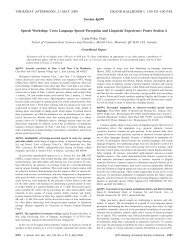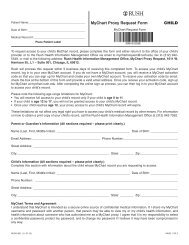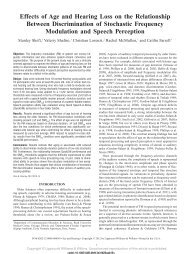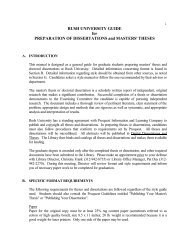Laparoscopy Information Sheet - Rush University Medical Center
Laparoscopy Information Sheet - Rush University Medical Center
Laparoscopy Information Sheet - Rush University Medical Center
Create successful ePaper yourself
Turn your PDF publications into a flip-book with our unique Google optimized e-Paper software.
Oopherectomy (Ovary Removal Surgery) <strong>Information</strong> <strong>Sheet</strong>General indications for the proposed procedure/treatment:Oophorectomy is a surgical procedure to remove one or both of the ovaries. The ovariesare almond-shaped organs that sit on each side of the uterus in the pelvis. The ovariescontain eggs and produce hormones that control the menstrual cycle.Oophorectomy can be done alone, in some cases. But it is often done as part of a largersurgery to remove the uterus (hysterectomy) in women who have undergone menopause.Oophorectomy is commonly combined with surgery to remove the nearby fallopian tubes(salpingectomy), since they share a common blood supply with the ovaries. Whencombined, the procedure is called salpingo-oophorectomy. A salpingo-oophorectomy isoften performed on women with an increased risk of ovarian cancer.When oophorectomy involves removing both ovaries, it's called bilateral oophorectomy.When the surgery involves removing only one ovary, it's called unilateral oophorectomy.Oophorectomy may be performed for:• A tubo-ovarian abscess — a pus-filled pocket involving a fallopian tube and anovary• Ovarian cancer• Endometriosis• Noncancerous (benign) ovarian tumors or cysts• Reducing the risk of ovarian cancer or breast cancer in women at increased risk• Ovarian torsion — the twisting of an ovaryDescription of Procedure:During oophorectomy surgery the patient will receive anesthetics to put her in a sleeplikestate. The patient will not be awake during the procedure.Oophorectomy can be performed two ways:1. Surgery using one large incision. During a traditional (open) oophorectomy, thesurgeon makes an incision in the abdomen to access the ovaries. The surgeonseparates each ovary from the blood supply and tissue that surrounds it andremoves the ovary.2. Surgery using multiple small incisions. Laparoscopic surgery involves makingthree or four small incisions in the abdomen. The surgeon inserts a tiny camerathrough one incision and special surgical tools through the others. The cameratransmits video to a monitor in the operating room that the surgeon uses to guidethe surgical tools. Each ovary is separated from the blood supply and surroundingtissue and placed in a pouch. The pouch is pulled out of the abdomen through oneof the small incisions.Laparoscopic oophorectomy may also be robotically assisted in certaincomplicated cases. During robotic surgery, the surgeon watches a 3-D monitorand uses hand controls that allow finer movement of the surgical tools.Date of Last Revision: 6/2010 1
Whether the oophorectomy is an open, laparoscopic or robotic procedure depends on thepatient’s situation. Laparoscopic or robotic oophorectomy usually offers quickerrecovery, less pain and a shorter hospital stay. But it isn't appropriate for everyone, and insome cases, surgery that begins as laparoscopy may need to be converted to an openprocedure during the operation.After oophorectomy, the patient can expect to spend several hours in a recovery room asthe anesthesia wears off. The patient may move to a hospital room where she may spenda few hours to a few days, depending on the procedure.Risk of the Procedure:Oophorectomy is a relatively safe procedure that carries a small risk of complications,including, bleeding, infection, damage to nearby organs, rupture of a tumor, spillingpotentially cancerous cells into the body, and retention of ovary cells that continue tocause signs and symptoms, such as pelvic pain, in premenopausal women.Women who have yet to undergo menopause will experience premature menopause ifboth ovaries are removed. This deprives the body of the hormones produced in theovaries, leading to complications such as:• Menopause signs and symptoms, such as hot flashes and vaginal dryness• Depression or anxiety• Heart disease• Memory problems• Decreased sex drive• Osteoporosis• Premature deathStudies have found that women who take low doses of hormone replacement drugs untilabout age 50 may reduce their risk of these complications. But hormone replacementtherapy has risks of its own. Discuss options with your doctor.Procedure Alternatives, if any:There are no alternatives to an oophorectomy.Probable consequences of Refusing Procedure:Depending on the reason for the procedure, the patient’s disease may continue and couldworsen over time.Person(s) Performing the Procedure:The key portions of the procedure will be performed by a physician who is a member ofthe medical staff of <strong>Rush</strong> <strong>University</strong> <strong>Medical</strong> <strong>Center</strong> and/or a resident/fellow who isobserved by a physician who is a member of the medical staff. Residents/Fellows arelicensed physicians in approved residency or post residency training programs. Parts ofthe procedure which they perform will be based on their level of competency.Date of Last Revision: 6/2010 2
















